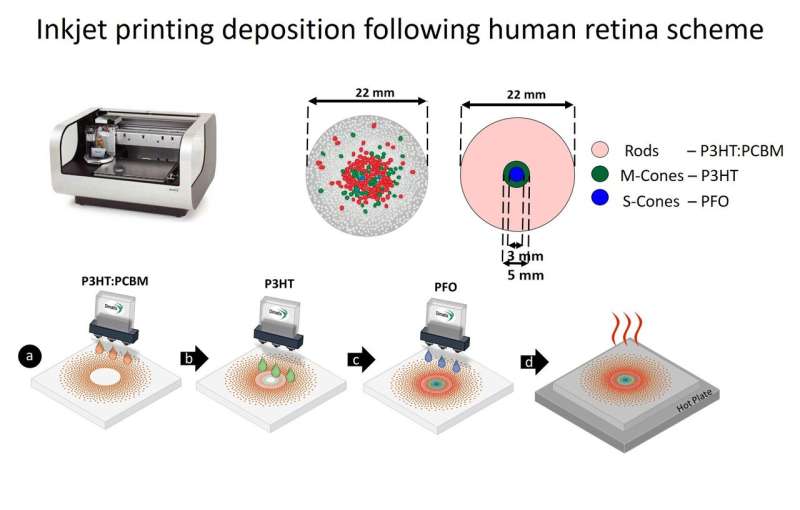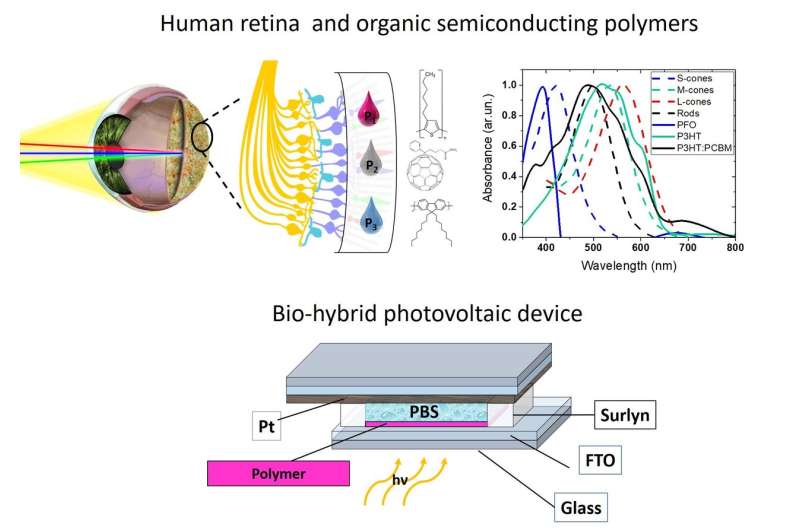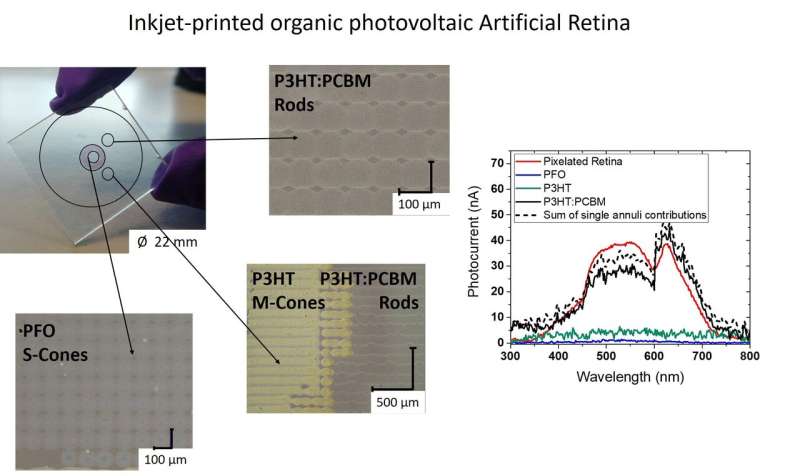Development of a color-sensitive, inkjet-printed, pixelated artificial retina model

Around 300 million people worldwide are visually impaired. Retinitis pigmentosa (RP) and age-related macular degeneration (AMD), involving deterioration of retinal photoreceptors-cells, are the leading causes of partial or total loss of vision. In the human eye, the retina contains several layers of cells including rod and cone photoreceptors that convert light into electrical signals and are responsible for night and color vision respectively. With the development of biomedical engineering in the last decades, retinal prostheses, designed to partially restore vision, have seen progress. However, those based on conventional silicon, metallic, or rigid electrodes possess poor flexibility and biocompatibility.
In recent years, photosensitive organic electronic materials have been shown to be a very promising tool, even transplanted in vivo, for transducing light stimuli to non-functioning retinas. The materials are mechanically flexible, so they are applicable to flexible and conformal substrates and can be deposited through inks. Up to now, the spectral responsivity was considered individually for one polymer semiconductor at a time in artificial retina applications. However, to contemplate color vision, pixelation of different polymers that are photosensitive to different parts of the visible spectrum (color sensitivity), mimicking those of the photoreceptors, is necessary.
A multidisciplinary international team with researchers from four research institutes has published the results of their project in an article in Scientific Reports.
The team members are from University of Rome Tor Vergata (Department of Electronic Engineering and Department of Biomedicine and Prevention), University of Surrey (Department of Electrical and Electronic Engineering, Faculty of Engineering and Physical Sciences, Advanced Technology Institute, Guildford, UK), Istituto di Struttura della Materia (CNR-ISM, Rome, Italy), Cicci Research srl. (Grosseto, Italy), and EMBL (European Molecular Biology Laboratory, Epigenetics and Neurobiology Unit, Monterotondo, Italy).

The team demonstrate the design and fabrication of a color-sensitive model of a pixelated artificial retina where each polymer dot was deposited by inkjet-printing (Figure 1). Three types of polymer semiconductors, with spectral absorbance curves emulating those of rods, and of cones which provide color sensitivity, were deposited in a concentric layout simplifying the anatomical human retinal scheme.
The team verified that the phototransduction process from the artificial retina to a biological electrolyte solution imitating extracellular fluids found in our tissues produced electrical signals compatible with those found in retinas through a novel closed sandwich-type optoelectronic device (Figure 2). The bio-hybrid device, which combines techniques used in electrophysiology, organic photovoltaics and dye-sensitized solar cells, presents some advantages compared to conventional electrophysiological investigative systems: it is compact, easy-to-handle, transportable, with controllable size and requires a small amount of bio-electrolyte thus permitting use of tools typically found in an electronic-engineering/physics/chemistry laboratory. Photosensing through three-color pixelation allowed incoming light to be resolved both spectrally and spatially. The biocompatibility of each type of photosensitive polymer was also demonstrated.

The number of pixels of the artificial retina model with distinct absorption spectra, mimicking the chromatic sensitivity of photoreceptors in the eye and interfaced with a physiological medium was 42100, the density of the artificial photoreceptors was ∼11,000 pixels/cm2 and the corresponding spatial resolution was 267 dpi (dots per inch), with pixel diameters of 95 micrometers comparable to that of a human hair (Figure 3). Future studies should compare and investigate the interaction of the artificial retina model with biological ones. Printing technologies enable placement of different materials in the locations of choice. In view of a future based on personalized medicine, and with the development of higher resolution techniques (i.e. ≤ 10 micrometers which is the diameter of human retinal photoreceptors), one could think of first imaging an individual retina and then printing the pixels so as to spatially reproduce their location.
More information: Manuela Ciocca et al. Colour-sensitive conjugated polymer inkjet-printed pixelated artificial retina model studied via a bio-hybrid photovoltaic device, Scientific Reports (2020). DOI: 10.1038/s41598-020-77819-z





















